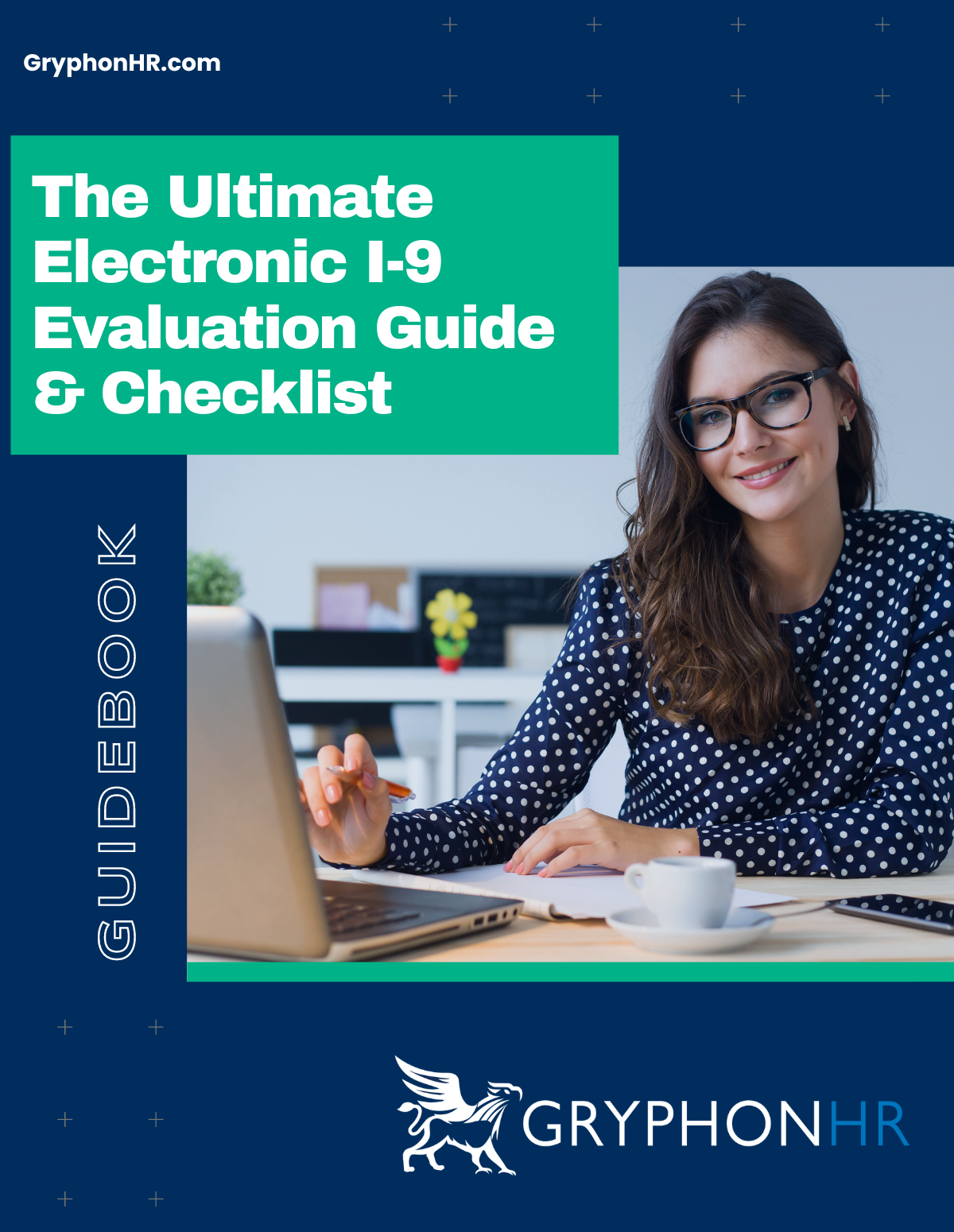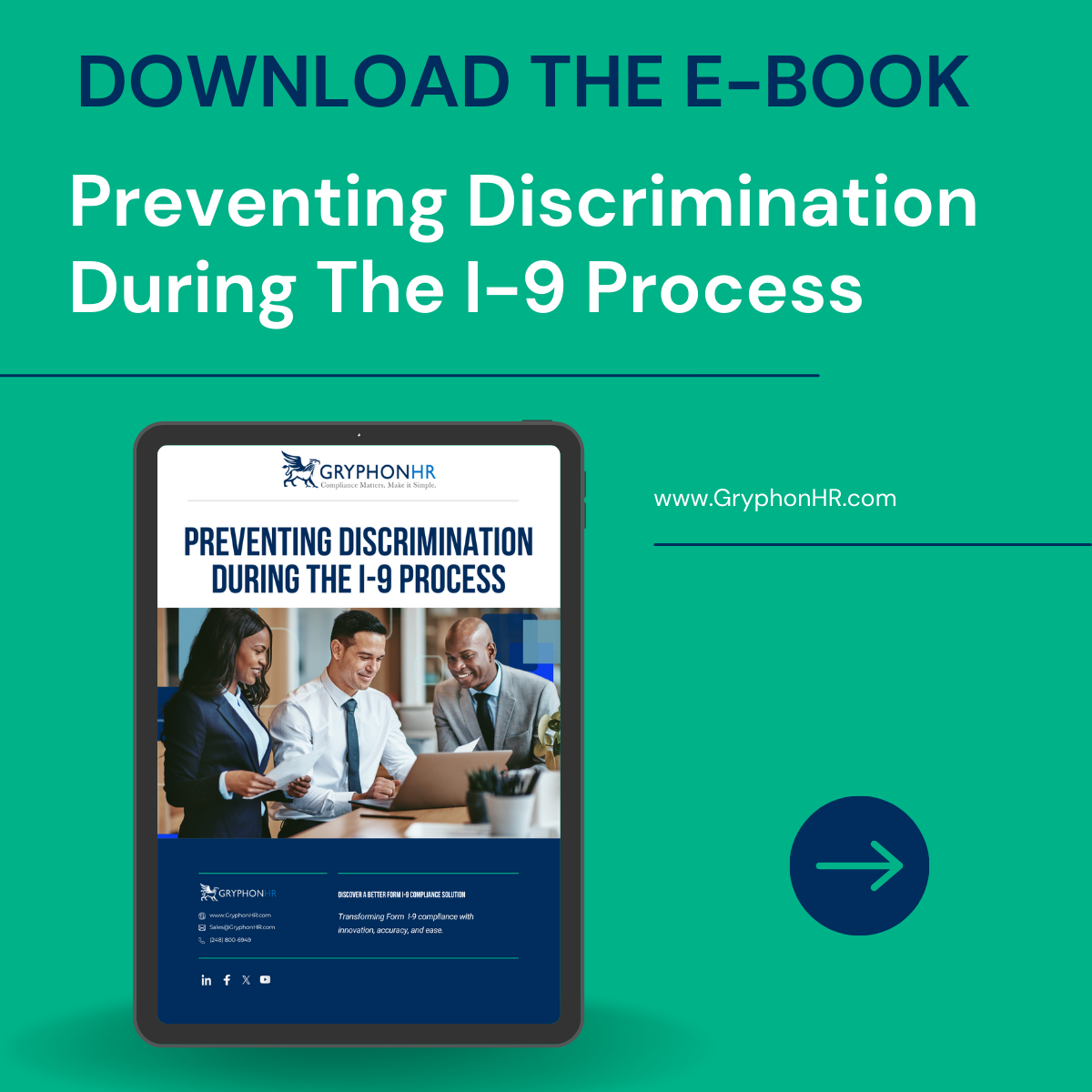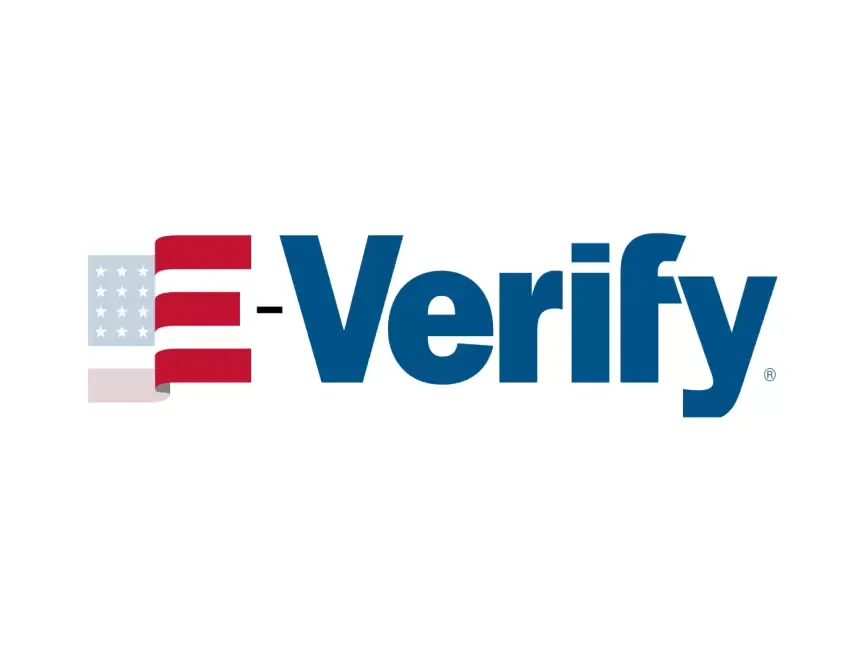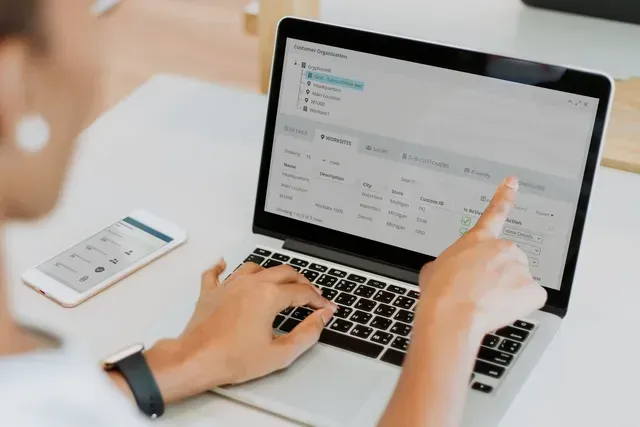Authored By: GryphonHR Blog Contributor
GryphonHR blog contributors include , consultants, researchers, and other subject-matter experts who’ve written content for our blog.
April 4, 2024
The trend of the DOJ actively seeking to make employers responsible for discriminatory actions in the Form I-9 verification process is increasingly being emphasized. In this article, we’ll review a recent case that illustrates the importance of adhering to Form I-9 document verification requirements, including best practices, resources, and insights.
Following a Department of Justice (DOJ) investigation and a recent settlement, a security services company has been ordered to pay over $100,000 for discrimination during the Form I-9 process. According to a DOJ announcement, Securitas Security Services USA Inc. (Securitas) violated the Immigration and Nationality Act (INA) by requiring lawful permanent residents to present specific work authorization documents for Form I-9 verification. The recent announcement also states that Securitas made similar requests of other employees who were not U.S. citizens.
The anti-discrimination provision of the INA is enforced by the Immigrant and Employee Rights Section (IER) of the DOJ’s Civil Rights Division. It includes a wide range of discriminatory practices, such as hiring, firing, recruitment, or referral for a fee, and unfair documentary practices - as noted in the Securitas case.
Employers must be sure to avoid requesting specific identification and employment authorization documents for Form I-9 verification. The INA's anti-discrimination provision prohibits employers from specifying or demanding particular documents for employment eligibility verification due to a worker's citizenship status, immigration status, or national origin. This provision ensures that all workers, including non-U.S. citizens who are legally eligible to work, are allowed to present any acceptable documentation of their choice.
Assistant Attorney General Kristen Clarke emphasized that federal law allows workers to choose which valid, legally acceptable documentation they present to prove their identity and permission to work, underscoring the principle of non-discrimination regardless of citizenship, immigration status, or national origin.
Form I-9 Verification: Know Your Documents
Employers should refer to “The Lists of Acceptable Documents” that accompanies the Form I-9 and should accept any document from List A, or a suitable combination of documents from List B and C to verify identity and employment authorization, as long as the document(s) seem authentic and pertain to the individual presenting them.
Documents listed under List A confirm an individual’s identity and authorization to work legally in the U.S. Such documents enable employers to validate both an employee's identity and their legal status to work without needing further documentation. Below are some examples of List A documents:
When List A documents are presented as a combination of multiple documents, they are collectively considered a single List A document for Form I-9 purposes. An example of this is the combination of a foreign passport and a Form I-94 or Form I-94A, which must carry the same name as the passport and an endorsement of the holder’s nonimmigrant status that permits employment with a particular employer based on their status. Once an acceptable List A document is provided, no additional documentation should be requested from the employee.
List B documents, which establish identity only, require employees to also present a List C document for employment eligibility verification. Examples of List B documents include driver’s licenses, I.D. cards, and, for individuals under 18, school I.D.s or hospital records. Conversely, List C documents verify employment eligibility alone, necessitating an accompanying List B document for identity verification. Examples of List C documents include Social Security Cards, the F-545 Certification of Birth Abroad issued by the U.S. Department of State, and the Form I-571 Refugee Travel Document.
USCIS recently updated guidance for the Lists of Acceptable Documents with a focus on List C #7 documents. Sample images of these documents and detailed information about acceptable documentation can be found on I-9 Central and in the M-274, Handbook for Employers. Refer to the following sections:
Receipts may be accepted for certain documents that have been lost, stolen, or damaged for a temporary period. More information about Form I-9 document receipts can be found in the M-274, Section 4.4 Acceptable Receipts.
In recent years, there has been a noticeable shift in the focus of Form I-9 compliance efforts. While Immigration and Customs Enforcement (ICE) continues to perform Form I-9 worksite audits, there is a growing emphasis on cases related to Form I-9 discrimination, primarily handled by the Department of Justice. Although ICE remains in charge of I-9 audits, employers need to stay informed about joint investigations by different agencies. Notably, there has been a significant rise in DOJ settlements concerning unfair and discriminatory practices during the I-9 document review process, and this trend appears likely to continue.
Businesses in the U.S. should equally prioritize compliance with I-9 document management practices and administrative Form I-9 procedures. Recent I-9 penalty adjustments have led to higher fines for non-compliance. Employers may face fines ranging from $281 to $2,789 for mistakes made on Form I-9. For engaging in unfair document practices, penalties vary between $230 and $2,304. A first offense of unfair immigration-related employment practices, the fines can range from $575 to $4,610.
Tackling the intricacies of Form I-9 compliance requires the proper tools, resources, education, and practices. The advancement of technology provides a valuable resource for employers looking to simplify their I-9 verification processes and firmly commit to non-discriminatory principles. Let’s explore how technology can serve as a supportive partner in this effort.
An electronic I-9 solution simplifies complex requirements, streamlines procedures, and reduces the risk of discrimination. Advanced Form I-9 software goes beyond data validation to offer comprehensive support throughout the Form I-9 process, ensuring the form is managed with accuracy and adherence to regulations. This should encompass compliance features that make the I-9 document review process straightforward and effective, including a workflow for compliant document verification, detailed guidance for I-9 documents with examples, and secure options for uploading and storing document images. Furthermore, your electronic I-9 system should adhere to all standards prescribed by USCIS and the DOJ, including specific requirements for I-9 applications.
Avoiding discrimination during the Form I-9 and E-Verify process is crucial for maintaining compliance with federal laws and fostering an inclusive workplace. Here are the best practices to ensure fairness and adherence to regulations:
Ensure that all personnel involved in the hiring and employment eligibility process are thoroughly trained on Form I-9 and E-Verify procedures. Training should emphasize the importance of following the guidelines without discrimination. Continued education and education can help to make sure your organization is on top of changing employment laws.
Many electronic I-9 solution vendors like GryphonHR also include training modules and resources to educate employers and HR personnel on the legal requirements of Form I-9 and E-Verify. This ongoing education is crucial for maintaining compliance and fostering a culture of inclusivity and respect for workers' rights.
Develop and implement a standardized process for all employees, regardless of their national origin, citizenship, or immigration status. This uniform approach helps prevent discriminatory practices.
When informing employees about the documents they can present for verification, ensure that all options from the Lists of Acceptable Documents are presented equally. Employees should be allowed to choose which documents they wish to present from the lists.
Do not request more or specific documents than are required for the Form I-9 process. Employees have the right to choose which acceptable document(s) they want to provide.
Do not reverify the employment eligibility of lawful permanent residents once they have presented a Form I-551, Permanent Resident Card, for the initial verification. Permanent residency status does not expire for employment verification purposes, even if the card itself has an expiration date.
If your organization participates in E-Verify, use it for all new hires in locations where it is required or has been elected to be used. Applying E-Verify only to individuals of certain national origins or citizenship statuses can be discriminatory.
When an employee receives a TNC from E-Verify, provide them with clear instructions on how to contest the TNC and the timeframe for doing so. Ensure they understand their rights and do not take adverse action against them while the TNC is being contested.
Maintain thorough documentation of the Form I-9 and E-Verify process for each employee. This includes records of any actions taken in response to TNCs and the rationale behind them.
Regularly review your organization's Form I-9 and E-Verify processes to identify and correct any practices that could be construed as discriminatory. This can help preempt any issues before they escalate into legal problems.
The advancement of technology provides a valuable resource for employers looking to simplify their I-9 verification processes and firmly commit to non-discriminatory principles. Let’s explore how technology can serve as a supportive partner in this effort.
An electronic I-9 solution simplifies complex requirements, streamlines procedures, and reduces the risk of discrimination. Advanced Form I-9 software goes beyond data validation to offer comprehensive support throughout the Form I-9 process, ensuring the form is managed with accuracy and adherence to regulations. This should encompass compliance features that make the I-9 document review process straightforward and effective, including a workflow for compliant document verification, detailed guidance for I-9 documents with examples, and secure options for uploading and storing document images. Furthermore, your electronic I-9 system should adhere to all standards prescribed by USCIS and the DOJ, including specific requirements for I-9 applications.
Check out our free “Ultimate Guide: Electronic I-9 Evaluation and Interactive Checklist” to help you compare electronic I-9 compliance solutions, or get in touch with our I-9 experts to uncover the capabilities of the GryphonHR Form I-9 and E-Verify platform.
The Securitas settlement serves as a crucial lesson for employers nationwide: the importance of complying with the INA's anti-discrimination provisions cannot be overstated. By understanding the permissible documents for Form I-9 verification and leveraging technology to ensure compliance, businesses can safeguard against discrimination and hefty fines. Stay tuned to GryphonHR for more Form I-9 and E-Verify information and
register for our I-9 newsletter.

Authored By: GryphonHR Blog Contributor
GryphonHR blog contributors include , consultants, researchers, and other subject-matter experts who’ve written content for our blog.
Stay updated on Form I-9 and E-Verify!


Is your I-9 compliance software placing you at risk? Learn more about the compliance requirements for electronic I-9 systems and how to evaluate important features. Skip the form and download this interactive guide!

Avoiding discrimination during the Form I-9 process is critical to preventing liability, hefty fines, and unfair hiring practices. Download our free e-book to learn more.



MENU
STAY CONNECTED
Join our newsletter to learn more about Form I-9.